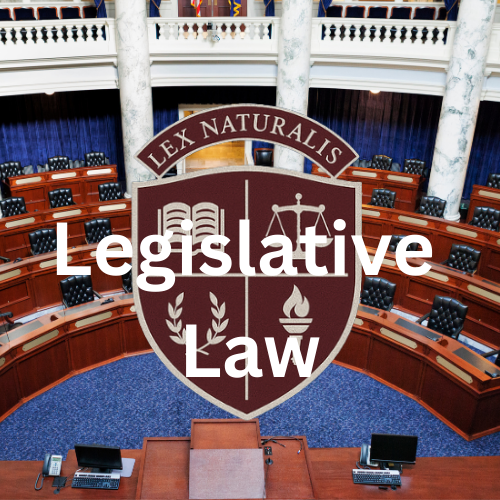Positive Law vs. Non-Positive Law: Why It Matters
- Dr. Byron Gillory
- Sep 8
- 4 min read

I. The Dignity of Codification
It hath ever been the care of civilized nations to reduce their laws into orderly form, that citizens may know the rule of their conduct, and magistrates may execute judgment without confusion. To this end, statutes are sometimes gathered, classified, and enacted as positive law—that is, codified enactments, authoritative and supreme in their written form. At other times, laws are compiled merely for convenience, arranged into titles or codes, but without being enacted anew; these are non-positive law, valuable indeed, but resting upon the authority of prior enactments and judicial decisions.
This distinction, though technical to the unlearned eye, is of profound significance. For in it lieth the very question of what is binding as law, and what is but evidence of law. To confound the two is to court confusion in the statute-book and in the courts of justice.
II. Positive Law: The Authority of Enactment
Positive law is that which hath been solemnly enacted and declared to be the authentic expression of the legislature. When Congress, for example, takes a title of the United States Code—say, Title 10 on the Armed Forces—and enacts it into positive law, the words therein become the final and controlling authority. Prior statutes, conflicting language, or scattered enactments are superseded; the codified text itself is law.
In such case, courts, citizens, and magistrates need look no further: the statute as codified is binding. Positive law giveth certainty, stability, and uniformity; it presenteth the law as a single body, not as a patchwork of scattered acts.
III. Non-Positive Law: Evidence of Enactment
Non-positive law, by contrast, consisteth of titles of code that have been compiled for convenience, but not enacted anew. They are excellent references, gathering statutes in orderly fashion, but they are not in themselves the law. They are but prima facie evidence of the law, which still resideth in the underlying public laws and acts of Congress.
Thus, if a conflict arise between the wording of a non-positive law title and the actual text of a statute as passed, the latter controlleth. The code is a guide, but not a final authority.
The distinction may seem subtle, but it mattereth greatly in practice. For where positive law governeth, the codified text is supreme; where non-positive law governeth, recourse must be had to the original enactments.
IV. Jurisprudential Significance
Why does this distinction matter beyond technical convenience? Because it toucheth the very philosophy of law.
Certainty vs. Ambiguity — Positive law bringeth certainty; non-positive law leaveth room for ambiguity, as lawyers must sometimes search through layers of enactments to discern true meaning.
Authority vs. Evidence — Positive law is authority itself; non-positive law is but evidence of authority, a finger pointing to the text, but not the text itself.
The Integrity of Statutory Drafting — Codification as positive law demandeth precision, for once enacted, the code text is binding. Non-positive compilations may contain errors or editorial choices, but these are corrigible by reference to the original statutes.
Thus the distinction is not mere pedantry. It is the very difference between law as enacted and law as compiled.
V. Blackstone’s Wisdom Recalled
Sir William Blackstone himself perceived the dignity of ordered codification, though in his day the common law had not been reduced into code. He praised the clarity of statutes that were plain, public, and certain, warning ever against obscurity and confusion. Though he lived in a realm of scattered enactments, his vision pointed toward the need for law accessible, knowable, and binding in form.
Had Blackstone beheld the distinction between positive and non-positive law as it existeth in modern America, he would have esteemed it of high importance. For he knew that “where the law is uncertain, there is no liberty.” Positive law removeth uncertainty; non-positive law preserveth history, but must not be mistaken for supreme authority.
VI. The Task of Legislative Law
Herein sits the charge of Legislative Law and of those who practice it. The Legislative Counselor must know not only how to draft statutes, but also how they will be codified, classified, and construed. He must distinguish between positive enactments and compilations, ensuring that his drafts are fit for codification and endure through generations.
At Gillory & Associates, this knowledge is cultivated with care. We do not leave codification to chance, nor confuse convenience with authority. Through the Blackwell Institute for Legal Studies, we train jurists to discern the anatomy of law, to guide legislatures in crafting statutes that may enter the code as positive law, and to safeguard the integrity of the statute-book.
VII. Conclusion: Why It Matters
To the careless, the difference between positive and non-positive law may appear as shadow and substance. Yet to the jurist, the legislator, and the citizen, it is the difference between certainty and confusion, between authority and evidence, between command and commentary.
Positive law giveth us a final text, binding and supreme. Non-positive law pointeth us to enactments, useful but not decisive. To know the distinction is to walk securely in jurisprudence; to neglect it is to stumble amidst uncertainty.
Therefore let us recover the wisdom that codification is not a mere technicality, but a safeguard of liberty itself. And let Legislative Law, as a discipline, continue to remind us that statutes must not only be passed—they must be ordered, codified, and understood, if they are to serve the people with justice and endure for ages.
Comments